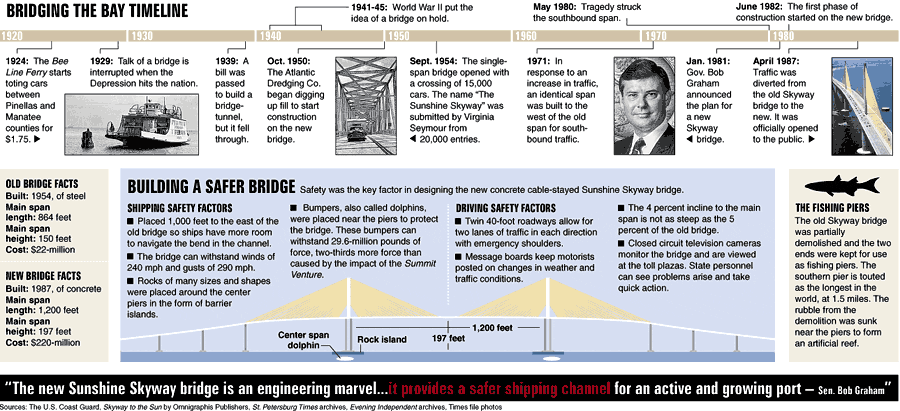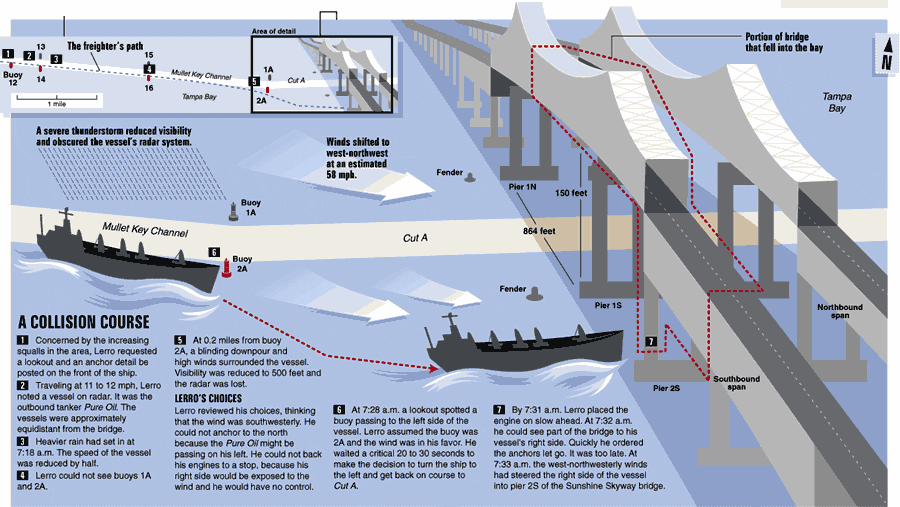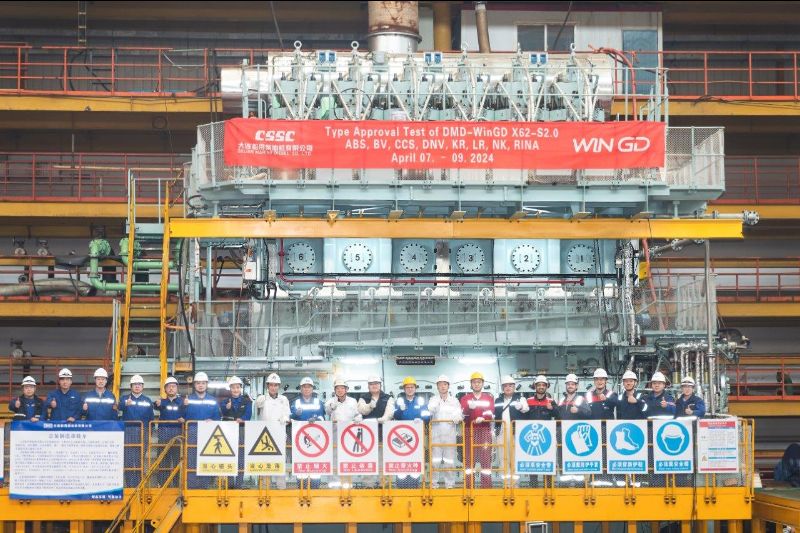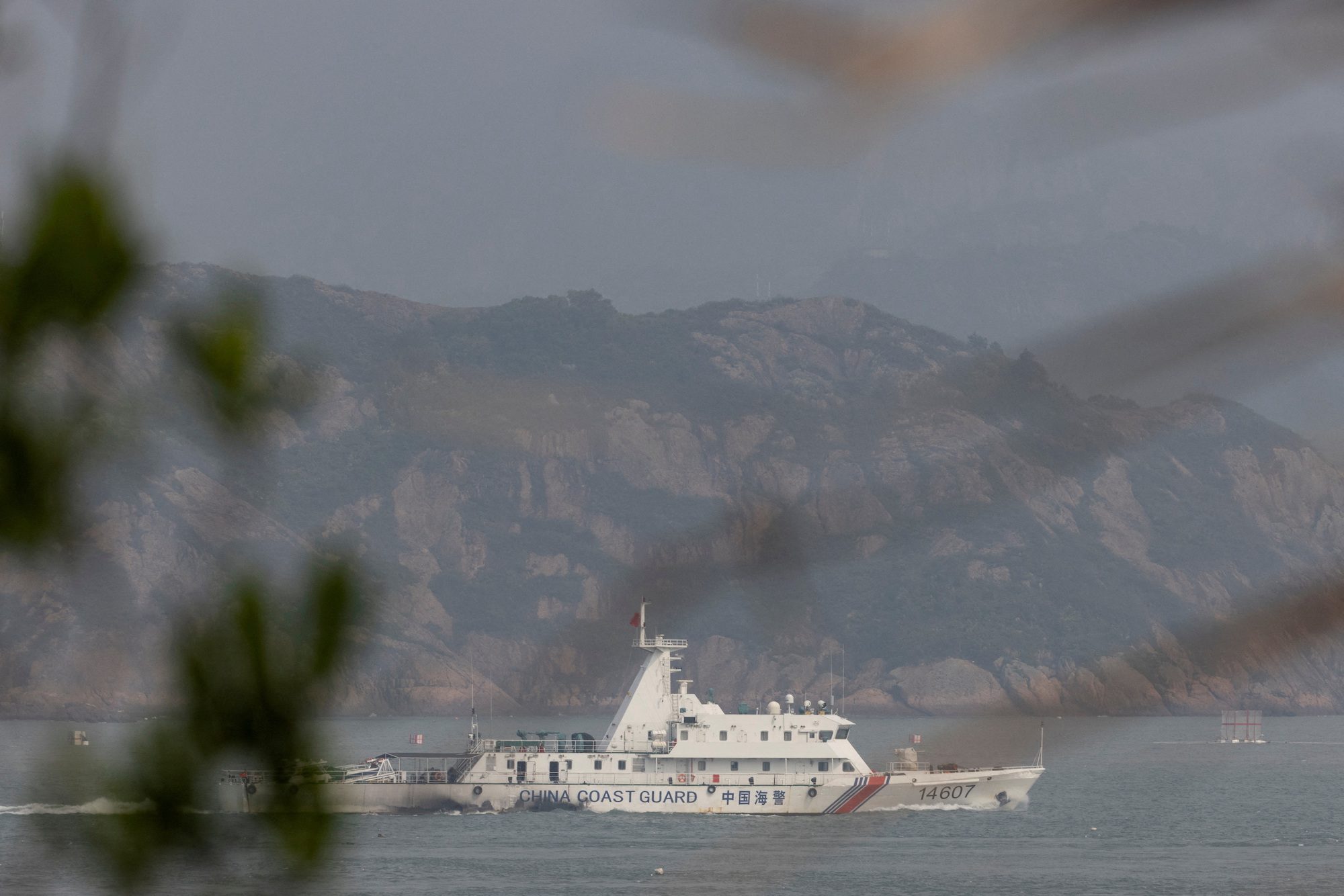Skyway Bridge Accident And Collapse – May 9, 1980, Tampa Florida
In light of the Minnesota bridge collapse I wanted to share the mayday called immediately following the Skyway Bridge Collapse on May 9th 1980.
The Transcript from the Mayday Call:
They probably never met, Chip Callaway and Gerta Hedquist. Never nodded or smiled or even made eye contact. They had, after all, no mutual friends, no shared interests.
He was 20, an exceptional college student, on the school tennis team, standing on the brink of his life.
She was 92, stiffening with advanced arthritis, planning another trip to her native Sweden, undoubtedly the last given her growing physical limitations.
They had nothing in common at all.
Except, as they settled into their Greyhound bus seats, heading south under gray and threatening skies, they were about to die together.
At 7:25 a.m. on May 9, 1980, with the Greyhound approaching Pinellas Point a few miles from the north end of the Sunshine Skyway bridge, Capt. John Lerro tensed at the helm of the freighter Summit Venture, a ship as long as two football fields.
Lerro, 37, an experienced harbor pilot from Tampa, shouldered the responsibility of guiding the Summit Venture from the Gulf of Mexico 58.4 miles up Tampa Bay to the Port of Tampa. It is one of the longest shipping channels in the world, and one of the most treacherous, given the shallow waters of the bay and the ambush style of Florida weather.
With the ship’s belly empty of cargo and her tanks nearly empty of ballast, she rode high in the water.
She ran through intermittent fog and rain along the first 19 miles of her journey. Then southwest winds exploded to tropical-storm force. Rain sheeted at rates exceeding 7 inches an hour. Visibility plunged to near zero, and shipboard radar failed.
It couldn’t have happened at a worse point. Lerro faced the most critical course change of the run, a 13-degree turn that would take him between the two main piers of the Skyway bridge.
It was at almost this exact spot that the Coast Guard cutter Blackthorn had been rammed four months earlier by the tanker Capricorn. The Blackthorn sank. Twenty-three men died.
Lerro approached the critical bend on a ship weighing nearly 20,000 tons battered by winds of nearly 60 mph.
And he approached it blind.
Anthony Gattus didn’t like what he saw at all.
“It was a lousy day to start with,” Gattus recalled. “It started raining hard 2 or 3 miles before we got to the Skyway. It got really dark. I don’t like rain and cold and darkness. Didn’t then. Don’t now.”
Gattus, now 81, was a passenger in a yellow Buick headed south with three other men to ferry cars back for sale in Pinellas County. Richard Hornbuckle, the owner of the Buick, was behind the wheel. Jim Crispin sat beside Hornbuckle in the front seat. Kenneth Holmes sat beside Gattus in back.
“Hornbuckle was a real good driver,” Gattus said. “I always felt safe with him. When the rain started hard, he slowed way down. Twenty. Don’t think he could have been going faster than 20 mph. “I remember a blue pickup passed us.
“I remember a bus passed us.”
On the water below, Lerro considered his options.
Visibility was so bad he could no longer see the bow of his ship. He judged it too risky to turn the Summit Venture out of the shipping channel to the north to anchor and ride out the storm because the outbound Pure Oil had been approaching. Without radar or visibility to locate the tanker, Lerro feared he might ram her if he steered across her path.
If he tried to stop, or if he turned south out of the channel, the winds could usurp control of the ship and hurl him into the bridge.
Thinking the wind was still from the southwest, his right, Lerro judged it would push the Summit Venture safely through the main spans of the Skyway.
He made the decision to proceed.
Lerro didn’t know the squall had forced the wind around to the west-northwest, his left. Instead of keeping him in the channel, it pushed his high-riding vessel off course.
At 7:32, the weather cleared marginally. Lerro saw part of the bridge superstructure directly ahead. With heartstopping clarity, he realized he was no longer in the shipping channel.
He ordered a series of maneuvers, including emergency reversal of the engines and the deployment of the anchors. But it was too late.
At 7:33, the bow of the Summit Venture collided with bridge pier 2S. The pier toppled, taking the roadway with it.
On the bridge above and in the water below, terror of such magnitude no one could have dreamed filled the final seconds of 35 lives. In the hours that followed, it changed dozens more lives forever.
The horror in Lerro’s voice is painful to hear:
Lerro: Mayday! Mayday! Mayday! Coast Guard. Mayday! Mayday! Mayday! Coast Guard.
Coast Guard: Vessel calling Mayday, vessel in distress. This is the United States Coast Guard, St. Petersburg, Florida. Request your position, the nature of distress and the number of persons on board. Over.
Lerro: Get emergency . . . all the emergency equipment out to the Skyway bridge. Vessel has just hit the Skyway bridge. The Skyway bridge is down! Get all emergency equipment out to the Skyway bridge. The Skyway bridge is down. This is Mayday. Emergency situation. (Nearly screaming) Stop the traffic on that Skyway bridge!”
CG: This is Coast Guard St. Petersburg, roger. What size is the vessel that hit the bridge? Over.
Lerro: It’s a large vessel. Stop the traffic on the Skyway bridge. There’s some people in the water. Get emergency equipment out to the Skyway bridge. Now.
CG: This is the Coast Guard, St. Petersburg. Roger. What vessel are you on? Over.
Lerro: Summit Venture. Summit Venture.
CG: Summit Venture, Coast Guard St. Petersburg, roger. What is the size of your vessel and can you assist? Over.
Lerro: Cannot assist. We’re 606 feet long, light draft. We cannot assist here. We’re on an abutment. Stop all the traffic on the bridge. Send some vessels out here to render assistance. People are in the water.
One hundred and fifty feet above, the yellow Buick with Anthony Gattus in the back seat began to skid. The tires fought to obey the brakes and grab traction on the wet grating.
Hornbuckle, the driver, had not seen the center span of the roadway disappear. But as his car neared the crest of the bridge, he realized the upper superstructure was missing. That was the tip that saved their lives, he told Gattus later. He realized something was terribly wrong and started braking immediately.
The car slowed reluctantly. It stopped with the left front tire 14 inches from oblivion.
“The doors flew open,” Gattus recalled. “We all got out. We were on a sharp incline toward the water. I stuck my fingers through the grating and began to crawl away. I looked back, and Hornbuckle was still by the car. I yelled at him, “What are you still doing there?’ He said he was going back for his golf clubs.”
Below the Buick, the Greyhound bus that carried Chip Callaway, Gerta Hedquist and 24 other people to their deaths lay on its roof, as retired St. Petersburg fire Chief Jerry Knight recalled it, “split open like a ripe tomato.”
Also in the water was a 1980 silver Chevrolet Citation carrying a couple from Pinellas Park, a 1979 green Chevrolet Nova carrying a man from St. Petersburg, a 1980 light blue Ford Grenada carrying a man from Tampa, a 1975 black-and-yellow Ford sedan carrying a St. Petersburg couple, a 1976 white-and-tan Chevrolet El Camino carrying a man from Seminole and a 1979 silver Volkswagen Scirocco carrying a couple from Pennsville, N.J.
Autopsies revealed that 28 of the victims, including Hedquist, died of blunt trauma injuries; seven, including Callaway, drowned.
The 1974 blue Ford Courier pickup that passed Hornbuckle had gone over the edge as well. Along with part of the bridge superstructure, the truck fell onto the Summit Venture’s bow. The Courier then rolled into the water. The lone occupant, Wesley MacIntire, survived.
It haunted him for the final nine years of his life that he lived when others perished.
“We had no idea what we were dealing with until we came around (Maximo) Point and saw the bridge down,” said Bill Covert. “It was horrific.”
For more than 20 years, Covert has run a search-and-rescue training program at Eckerd College at the southern tip of Pinellas County. In 1980, none of the region’s fire and police authorities had formal dive teams. When search-and-rescue operations were needed, the call went to Covert.
Working from two boats, Covert’s crew pulled seven bodies from the water, final expressions of terror frozen on their faces.
“We were riding very low in the water, we had no capacity for more bodies, and the weather was deteriorating again,” he said. “We headed in for Fort De Soto Park, where the temporary morgue was set up. We had run out of body bags. We had one body strapped to the dive platform behind the boat and had nothing to cover it with. We reported the situation, but we were told to come in anyway.
“Just as we were pulling up to the dock, I looked up and saw a man holding his child above his head so the kid could get a good look. It made me sick. I can’t get that image out of my mind. I’ll never get that image out of my mind.”
When a colleague told St. Petersburg fireman Gerard Chalmers the Skyway bridge had fallen, “I thought it was a joke, and a sick joke at that.”
After Chalmers, now a district fire chief, confirmed the information, he drove to Fort De Soto.
“In my mind going down there, somebody hit the bridge, they bumped it,” he said. “Maybe a car was in the water. When I walked out onto the fishing pier and saw it, well, it was just awesome. Unbelievable.”
Chalmers made the first dive to the bottom of the main channel 60 feet below the surface to locate vehicles and to check the current and visibility.
“One of the first things I saw was a pile of rivets, like an ant hill,” he said. “They had been sheared off. The force it would have taken, it was stunning.”
He swam through a sea of twisted metal, like a ruined Erector set. He found the El Camino.
“The victim was inside,” Chalmers recalled. “We couldn’t get him out. It was like a high-speed crash on the interstate. I recovered his briefcase. I marked the spot and moved on.”
For years, Chalmers couldn’t cross the remaining span if a ship was sailing underneath.
“If I saw a ship, I would slow down, so I didn’t get out on that center span until the ship was gone.”
Memories of the disaster remain vivid.
“There was so much tangled wreckage, so much impact damage to the vehicles,” he said. “And it was quiet. Very, very quiet.”
The noise and impact from the bridge’s fall had chased all marine life away.
“I remember thinking at one point, “I am the only living thing down here.’ ”
Tampa civil lawyer Steven Yerrid reached the Summit Venture soon after the accident, looking for Lerro. His firm, Holland & Knight, represented many of the harbor pilots.
“When I first saw the scene, this huge ship in the middle of a carnival merry-go-round of small boats with bodies floating up, I thought I would never forget it,” Yerrid recalled. “I was right. I never have.
“When I went aboard the ship and saw John, I thought I had never seen a soul so lost.”
Before they could get off the ship, Yerrid and Lerro had to run a gauntlet of officials wanting to interview the pilot.
“They all wanted to question him, and I understood that,” Yerrid said. “I kept telling them, “Yes, but not today.’ ”
He hid Lerro, his wife and son in a hotel under the name Yerrid, where they remained for weeks. But it didn’t shield them from public reaction.
“Over the weeks and months, John heard himself called an alcoholic, a homosexual, a murderer,” Yerrid said. “His life was threatened. My life was threatened. Someone stole my Irish setter and kept her for three days. They beat her and urinated on her and then put her back on my porch.
“That’s the kind of atmosphere it was.”
A state inquiry cleared Lerro of negligence. A Coast Guard inquiry found Lerro’s decision to proceed in zero visibility contributed to the crash.
But it also found a litany of situations beyond Lerro’s control: The localized storm “of enormous proportions” was not forecast. The tanker Pure Oil had turned out of the channel itself to lay at anchor during the storm, making way for the Summit Venture to do the same, but no one told Lerro. The pilot of a ship that had passed the Summit Venture and encountered the fierce storm never warned Lerro to expect it, though the pilot knew there were other ships in the storm’s path. The position of the Summit Venture denied Lerro the chance to sense the wind had changed.
“I still try to imagine what Lerro felt,” said Paul Scotti, a retired Coast Guard official who ran media operations during the aftermath of the disaster. “He’s standing on the bridge, and he’s suddenly blind. He doesn’t know where other traffic is. He thinks he’s going straight, but the wind is pushing him sideways.
“It’s like somebody put a black hood over his head and said, “Go ahead, navigate now.’ ”
The Summit Venture sailed for another 13 years. She was removed from the Liberian registry in November 1993 at the age of 17, and there is no record of her since.
The new Sunshine Skyway, connecting Pinellas and Manatee counties, is a model of grace. It leans to the west, its golden superstructure appearing like two sails steering the bridge to the sea.
It opened in 1987, four lanes of traffic on a single span. It rises to 197 feet above the water, nearly 50 feet higher than the old Skyway. But its grade is less precipitous, and many drivers take comfort that they don’t have to look through a steel-grate roadbed to the water so many feet below.
The channel passage beneath the bridge has been widened from 800 to 1,200 feet. And the new bridge was constructed farther away from that treacherous 13-degree turn in the channel that the Summit Venture failed to negotiate.
But the channel was never straightened, a fact that surprises Knight, the former fire chief.
“That turn played a major role in two tragic accidents,” Knight said.
The bridge structure is hollow concrete, far stronger than the steel of the old Skyway. The pilings that provide the bridge’s toehold in the bay are surrounded by doughnuts of boulders and guarded by 36 bumpers, called dolphins. The bumpers range from 47 to 64 feet in diameter, giant rounds of concrete wrapped in heavy wooden planks, all sitting on beds of rock. From above, the dolphins look like a giant game of pinball. They are meant to deflect or ground errant ships, and they do that job often.
A recent examination found that nearly every one of the dolphins had been rammed, even those 70 and 80 yards from the shipping channel. Just last Feb. 6, a shrimper hit one of the dolphins and sank.
Rockbars extend 200 feet from the main pilings toward the direction from which traffic is supposed to approach the bridge, and so far, everything has worked. So far, the bridge is undamaged by traffic. Are the protections enough to keep the 1980 tragedy from happening again?
“It sounds foolproof, but a ship with a large overhang above the water line could have the hull run aground and still have the reach to hit a piling,” said J. Michael Buffington, who has been a Tampa Bay harbor pilot for nearly 20 years and sits on the state Board of Pilot Commissioners.
“It’s just a very tough bay to negotiate,” Buffington said. “It might be perfectly clear when you start out, and before you hit the sea buoy, you’re in the middle of a horrendous storm.
“Hopefully, this was a once-in-a-century incident. But who knows? Not long ago I was taking a refrigerated cargo ship into Port Manatee. I was above the bridge when I got hit with a huge squall. I lost control of the ship. I could not steer her. I could not change her heading. All I could do was order full astern and anchor until it cleared.
“If I hadn’t been above the bridge, who knows what might have happened?”
The survivors and families of the Skyway disaster lived with their experience in different ways.
Anthony Gattus lives in the same house in Clearwater he lived in then, and he said he rarely gives the old bridge a thought.
“I value having my family and my health, but I valued those things back then,” Gattus said. “I value life, but I valued life before. It doesn’t bother me.”
There is never a good time to die, but for 92-year-old Gerta Hedquist, the future held only pain and disappointment.
“For my mother, it might have been a godsend,” said Gilbert Hedquist, Gerta’s son. “I saw her a few weeks before she got on that bus. She said she had been to the doctor to see if she was okay for the trip to Europe. He said she could go, but it probably would be the last time because of the arthritis.
The Summit Venture prior to incident (from ShipSpotter Markus Berger)“I hated the thought of seeing her bedridden. She led such an active life. It would have killed her.”
For Grace Callaway, though, it couldn’t have been worse. Her son, John H. Callaway Jr., the boy they called Chip, the youngest of five children, would have been a junior in engineering at the Tuskegee Institute in Alabama. He was on his college tennis team. And he should not have been on that bus on that day.
“Ordinarily, he would have taken a bus down the east coast of Florida (to his home in Miami), but he couldn’t get a ticket because of the time of the year,” Callaway said.
After Chip’s death, the Tuskegee Institute named a tennis tournament for him.
“We went for years,” his mother said. “We haven’t gone the last four or five years, though, because it is hard for my husband to drive. We both have health problems. I’m convinced Chip’s death is a contributing factor.”
As Callaway talks about her son, it is overcast and stormy outside her Apopka home.
“It’s just changed our lives,” she said. “On a day like today, when it’s rainy and dreary like it was the day the bus went off the bridge, it all comes back. Every time I hear of a Columbine or of a parent losing a child, it plays all over again.
“It never goes away.”
Links:
- Fox video Archive – May, 1980
- Driving the old Skyway Bridge – Video
- PBS – Building the new Skyway Bridge

Subscribe for Daily Maritime Insights
Sign up for gCaptain’s newsletter and never miss an update
— trusted by our 109,120 members

Get The Industry’s Go-To News
Subscribe to gCaptain Daily and stay informed with the latest global maritime and offshore news

 Join The Club
Join The Club












